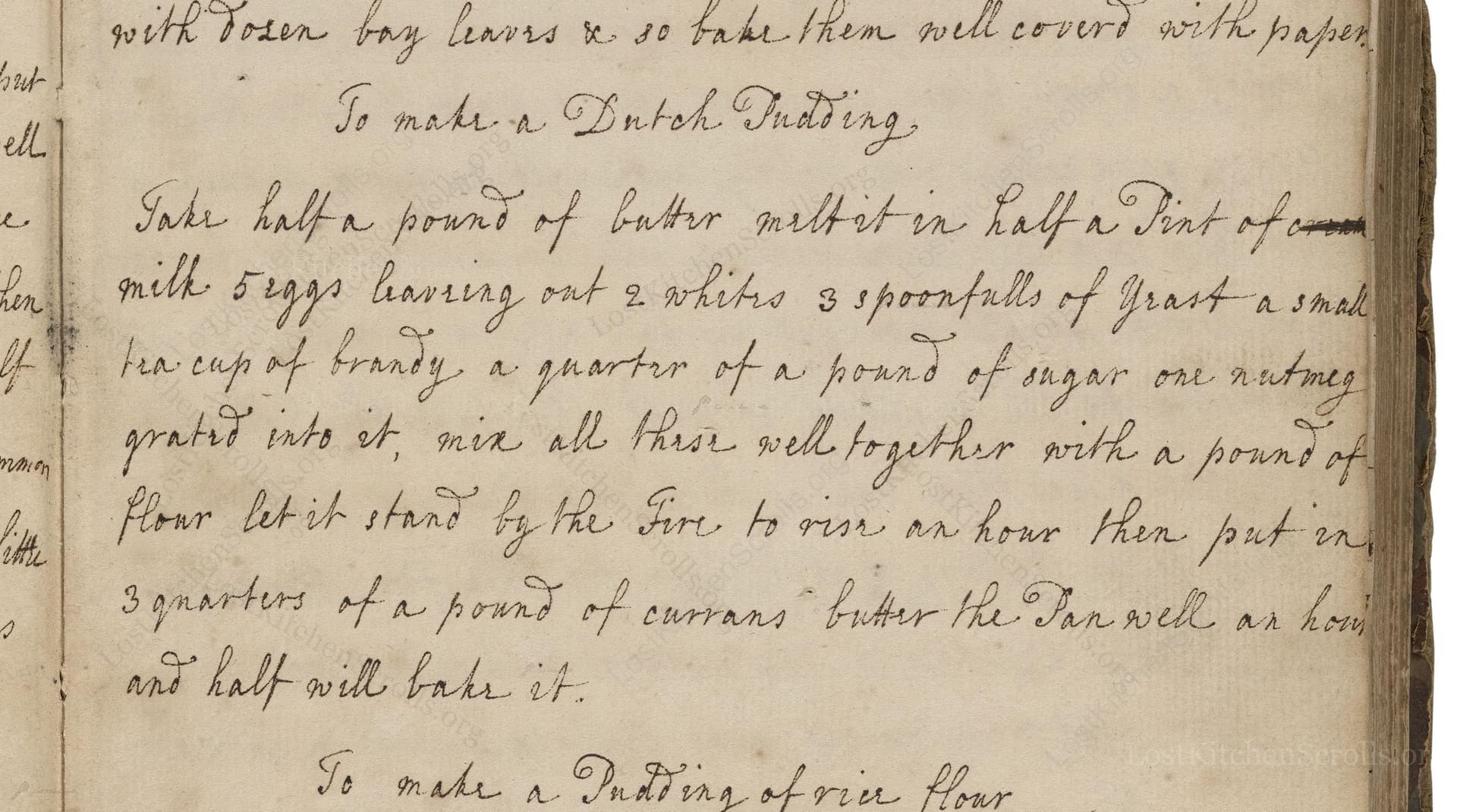To Make A Dutch Pudding
From the treasured pages of Cookbook of Elizabeth Langley
Written by Elizabeth Langley

To Make A Dutch Pudding
"Take half a pound of butterr melt it in half a Pint of milk 5 eggs leaving out 2 whites 3 spoonfulls of yeast a small tea cup of brandy a quarter of a pound of sugar one nutmeg grated into it, mix all these well together with a pound of flour let it stand by the fire to rise an hour then put in 3 quarters of a pound of currants butterr the Pan well an hour and half will bake it."
Note on the Original Text
18th-century recipes like this favored brevity and assumed much background knowledge from the reader. Weights are given in pounds and pints, with some measures ('tea cup', 'spoonfull') left a bit imprecise, reflecting the less standardized utensils of the time. The original spelling ('yeast', 'spoonfulls', 'lett') can vary, and punctuation is sparse. Instructions often omit temperatures or timings unless crucial, expecting cooks to use their experience, senses, and the ambient warmth of their hearths. The writing is direct, without steps or ingredient lists as we expect today, and incorporates the preparation seamlessly into a single paragraph.

Title
Cookbook of Elizabeth Langley (1757)
You can also click the book image above to peruse the original tome
Writer
Elizabeth Langley
Era
1757
Publisher
Unknown
Background
Step into the Georgian kitchen with Elizabeth Langley's 1757 culinary collection, where refined techniques and delightful recipes await those with a taste for historic gastronomy.
Kindly made available by
Folger Shakespeare Library
This Dutch Pudding recipe hails from the mid-18th century and is attributed to Elizabeth Langley, who was active around 1757. The term 'Dutch' often referred in English cookery to dishes influenced by continental European practices, particularly those from the Netherlands and Flanders, known for enriched breads and puddings. Recipes like this one were part of genteel English households, where enriched yeast-leavened puddings were served as desserts or even as substantial breakfast dishes. The inclusion of foreign spirits like brandy and an abundance of butter and eggs points to a recipe designed for festive or special occasions.

In the 18th century, the butter and milk would have been melted together in a small saucepan over a hearth or stove. Mixing would have been accomplished with a wooden spoon or perhaps a whisk, if available. The batter would be left to rise near the warmth of the fire, probably in a covered earthenware or wooden bowl. Baking was done in a well-buttered pan—often ceramic, metal, or even tin—placed in an oven heated by wood or coal, or sometimes baked in a Dutch oven directly before the fire.
Prep Time
30 mins
Cook Time
1 hr 30 mins
Servings
12
We've done our best to adapt this historical recipe for modern kitchens, but some details may still need refinement. We warmly welcome feedback from fellow cooks and culinary historians — your insights support the entire community!
Ingredients
- 8 ounces unsalted butter
- 9.5 fl oz (1 1/8 cups) whole milk
- 5 eggs (use 3 whole eggs and 2 yolks)
- 3 tablespoons active dry yeast (or 3/4 ounce fresh yeast as a substitute; modern equivalents may vary—check packaging)
- 1/4 cup brandy
- 4 ounces (1/2 cup) granulated sugar
- 1 whole nutmeg, grated (or 1 teaspoon grated nutmeg)
- 1 pound (3 1/2 cups) plain (all-purpose) flour
- 12 ounces currants (or substitute with raisins or sultanas if necessary)
Instructions
- Begin by melting 8 ounces of butter in 9.5 fluid ounces (1 1/8 cups) of milk over gentle heat—don't let it boil.
- In a separate bowl, beat five eggs, but omit the whites of two, leaving you with three whole eggs and two yolks.
- Add 3 tablespoons (1 1/2 tablespoons if using fresh yeast; check package equivalence) of active dry yeast, 1/4 cup brandy, 4 ounces (1/2 cup) of sugar, and freshly grate one whole nutmeg into the mixture.
- Stir in 1 pound (3 1/2 cups) of plain flour until you have a smooth batter.
- Let this mixture rest, covered and in a warm place, for about an hour to rise.
- After rising, fold in 12 ounces of currants (if unavailable, substitute with raisins or sultanas).
- Butter a baking pan well, pour in the batter, then bake in a preheated oven at 340°F (170°C) for around 90 minutes, or until deeply golden and set.
- Enjoy warm, as would have been traditional, or cooled.
Estimated Calories
380 per serving
Cooking Estimates
It takes about 30 minutes to prepare the ingredients. The dough needs to rise for 1 hour before baking, and baking takes about 90 minutes. Each slice has an estimated calorie count if you cut the loaf into 12 servings.
As noted above, we have made our best effort to translate and adapt this historical recipe for modern kitchens, taking into account ingredients nowadays, cooking techniques, measurements, and so on. However, historical recipes often contain assumptions that require interpretation.
We'd love for anyone to help improve these adaptations. Community contributions are highly welcome. If you have suggestions, corrections, or cooking tips based on your experience with this recipe, please share them below.
Join the Discussion
Rate This Recipe

Den Bockfisch In Einer Fleisch Suppen Zu Kochen
This recipe hails from a German manuscript cookbook compiled in 1696, a time whe...

Die Grieß Nudlen Zumachen
This recipe comes from a rather mysterious manuscript cookbook, penned anonymous...

Ein Boudain
This recipe comes from an anonymous German-language manuscript cookbook from 169...

Ein Gesaltzen Citroni
This recipe, dating from 1696, comes from an extensive anonymous German cookbook...
Browse our complete collection of time-honored recipes



